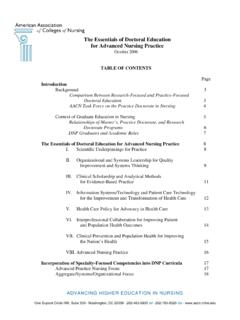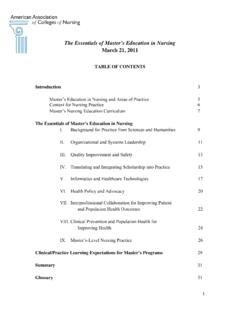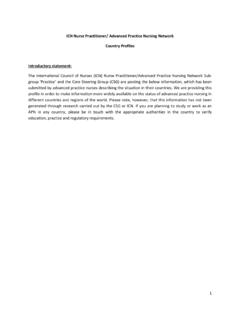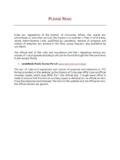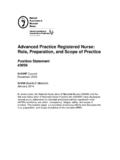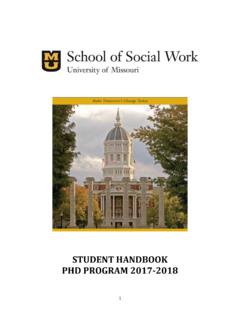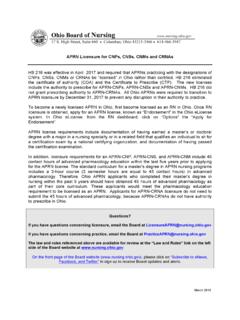Transcription of The Nursing Faculty Shortage - Indiana University
1 The Nursing Faculty Shortage : A Crisis For Health Care Karl D. Yordy, Spring 2006. The Nursing Faculty Shortage : A Crisis For Health Care . This research was supported by a grant from the Robert Wood Johnson Foundation to the Association of Academic Health Centers (AAHC). The full research paper is available on the AAHC Web site as part of the Factors Affecting the Health Workforce compendium: EXECUTIVE SUMMARY. The Shortage of Nursing Faculty in the United States is a critical problem that directly affects the nation's nurse Shortage , which is projected to worsen in future years.
2 Short- term interventions to address the Nursing Shortage are inadequate given the increasing needs of a growing and aging population. A substantial increase in newly educated nurses will be needed to meet future demand; therefore, timely and sustainable interventions to reduce the Nursing Faculty Shortage are required. This paper highlights solutions to the Faculty Shortage by: describing the current Faculty Shortage in relation to demand, supply, educational preparation and productivity;. examining the factors that contribute to the Faculty Shortage ;. reviewing the array of interventions already undertaken; and outlining recommendations for further action.
3 The paper is based on a review of published literature and data, including surveys by government and professional organizations, studies by state task forces addressing the Nursing Shortage , foundation reports, and reviews by such groups as the National Conference of State Legislatures of activities at the state level, as well as author inter- views with leaders in Nursing education. The Nursing Faculty Shortage : A Crisis For Health Care . THE PROBLEM. A substantial increase in newly educated nurses will be needed to meet projected future demand. Consequently, increased supply will require a major expansion of Nursing Faculty and other educational resources.
4 The following four elements deter- mine the adequacy of Faculty to meet future needs: demand, supply, educational preparation and productivity. Demand Demand for newly educated nurses influences demand for Faculty . Federal agencies have projected a significant increase in new Nursing positions based on the growth and aging of the population and their associated health care needs, coupled with continual development of medical technology and practice that are heavily dependent on nurses. The Bureau of Labor Statistics projects a 27 percent increase in Nursing jobs by 2012.
5 From 2002, the largest increase for any occupation, and the Health Resources and Services Administration (HRSA) has projected a similarly large increase in demand for nurses, from about 2 million full-time equivalents in 2000 to about million in 2020. Meeting the projected demand for new nurses in 2020 will require a significant increase in Nursing graduates, perhaps by as much as 50 percent, to fill new Nursing positions as well as to account for attrition from an aging workforce. This corresponds to an increase in the demand for Nursing Faculty . Furthermore, if hospitals continue seeking nurses with Bachelor of Science degrees (BSN) for advanced practice, demand for Faculty may increase further because the gross ratios of Faculty to students in BSN.
6 Programs are higher than for other forms of entry-level , 2. Supply Substantial evidence at both the national and state levels shows that the current inade- quate supply of Nursing Faculty constrains the level of enrollment in Nursing programs necessary to meet future demand of nurses. For instance, a national survey indicates that 33,000 qualified applications to Nursing programs were turned down, and percent of the surveyed schools indicated that Shortage of Faculty was the main factor limiting State surveys reveal similar findings. Increases in graduates from advanced educational programs that are the principal source of new Faculty lag behind overall increases in Nursing enrollments, with 405 doctoral graduates in 2004, an increase of only eight graduates from 2003.
7 In addition, adequacy of future Faculty supply will be strongly influenced by the high average age of Nursing Faculty , which is linked to the age at which nurses complete academic training for the Faculty role, especially at the doctorate level. The mean age at the award of the doctorate was about 46 in In 2001 the American Association of Colleges of Nursing (AACN) found that the mean and median age of doctorate-prepared Faculty was about 53; for masters-prepared Faculty , the mean and median age was about 49. Not only do nurses typically enter the Faculty role relatively late in their careers, but they retire at a relatively young age, on average.
8 The Nursing Faculty Shortage : A Crisis For Health Care Retirement of Faculty is projected to peak in 2010, just when the demand for newly trained nurses is at its Educational Preparation of Faculty To educate nurses for an increasingly complex health care environment, many leaders in Nursing education have called for raising the standards for Faculty academic creden- tials to the doctorate level. Therefore, strategies for increasing the supply of Nursing Faculty should also aim to enhance rigor in academic preparation. A relatively small proportion of Nursing schools provide research-oriented doctoral training: about 17 percent (93 schools) of the member schools of the American Asso- ciation of Colleges of Nursing and less than 7 percent of all 1,376 Nursing schools that provide basic education for , 7 The number of students in these doctoral programs is also relatively small, with 1603 full-time and 1,836 part-time students, and only 412 graduates in 2004, an average of about per doctoral program.
9 Although the number of graduates by school is not available, it is likely that these graduates are not evenly distributed among all 93 programs, meaning that some programs probably have one or two (or even fewer) graduates per year. The total number of doctoral graduates is about percent of all graduates of Nursing programs preparing RNs, and not all of these doctoral graduates end up in Faculty positions. Despite the need for highly qualified Faculty , enforcing higher academic standards makes increasing supply even more challenging. The process for preparing new Faculty is already lengthy.
10 Furthermore, higher academic standards may also discourage some from pursuing a Faculty career. Productivity Enhancing Faculty productivity to accommodate higher levels of enrollment in Nursing programs should complement efforts to increase Faculty supply. A signifi- cant measure of Faculty productivity is the ratio of Faculty to students or graduates. Associate degree programs produce more graduates and more RNs per Faculty member than do BSN , 9 Some interventions such as incentives given to Faculty in Texas to work overtime try to address this crude measure by attempting to lower the Faculty -to-student Many academic institutions use other measures of productivity such as scholarly publications, professional presentations and grant support to determine tenure and promotion.
